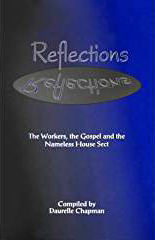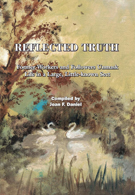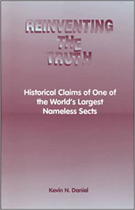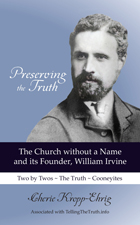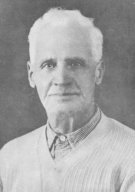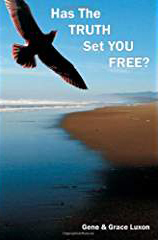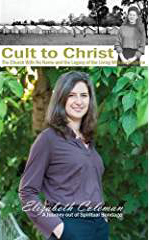July 22, 1999- Statement by Keith H. Percival, General Director of Faith Mission
May 29, 1991 - Letter by Rev. C. N. Peckham, Principal of Faith Mission
1895-1901 - Irvine's Experience in the Faith Mission
Who Was John George (J.G.) Govan?
Publications by or about The Faith Mission
Bright Words - A Faith Mission Monthly Publication
Who Was Rev. William P. Nicholson?
FAITH MISSION HEADQUARTERS
Address: 548 Gilmerton Road, Gilmerton, Edinburgh, Scotland EH17 7JD
website: http://www.faithmission.org
Faith Mission
Statement by Keith H. Percival, General Director
Regarding William Irvine's Service with Faith Mission
The Faith Mission and William Irvine
The Faith Mission is an 'interdenominational' mission working with the major protestant denominations who accept the simple truth of the Gospel; ie that salvation is by faith in Christ alone.
William Irvine was converted as a young man and joined The Faith Mission in 1895. He worked in the South of Ireland and had very successful missions within the different denominations. He became very critical of these churches and started to work independently. He eventually broke away from The Faith Mission and became very legalistic with the emphasis of salvation being on 'what you do' rather than by faith alone. (Obviously we believe that such faith must be expressed in one's lifestyle).
Our magazines of that period record William Irvine's time with us. I also have the diary of someone who worked with him in those days. Much of the Cooneyite way of working was identical to that of The Faith Mission and was certainly not a new revelation from the Lord. At least two of our families working with the Mission now, still have relatives in the 'Cooneyites'.
Keith H. Percival
General Director
Faith Mission
Letter by Rev. Colin N. Peckham, Principal
Regarding William Irvine's Service with Faith Mission
THE FAITH MISSION
(Founded 1886)
BIBLE COLLEGE
Tel.: O31-664 4336
2 Drum Street Gilmerton
Edinburgh EH17 8QG
Scotland
Principal: Rev. C. N. Peckham, B.A., M.Th
29th. May, 1991.
Re: William Irvine.
Dear Mrs. Kropp
In reply to your request for information concerning William Irvine's connection with the Faith Mission, William Irvine joined the Faith Mission in l895, and after working in Scotland, came across to Ireland probably around May of 1896. The Faith Mission was founded by J.G. Govan in 1886, as an evangelistic agency for the villages of Scotland, and the work was extended to Ireland in 1892. At some time in 1897, Mr. Irvine went to work in the south of Ireland, where he is referred to in our magazine Bright Words as superintending the Work there from 1898 to 1900. The last reference to him as such, is the issue of Nov/Dec. 1900.
There is reference in what we call "Location of Pilgrims" to a mission in Rathmolyon beginning Oct 10, 1897, by William Irvine following which he went to Co. Tipperary.
In the magazine issue for June/July, 1898 the report of the Work by Mrs. Pendreigh appeared as follows:
"Since coming across to...the south of Ireland, we have thoroughly enjoyed the Work. In some places the opposition was great, but by prayer and patient endurance battles were fought and won....During some missions several (Roman Catholics) were brought in, and I believe savingly converted...most of the work has been in and around Co. Tipperary, and one or two fully successful missions in Kings and Queen's Counties....I don't think any of us could go away with a grudge in our hearts...as our D. P. (District Pilgrim) has the happy plan of making us cross hands...and sing some chorus as a pledge of being true to God and to one another."
The D.P. referred to was, of course, William Irvine , and Mrs. Pendreigh later became one of his most devoted followers and remained so all her life.
In the August, 1898 issue of our magazine, William Irvine's name appears for the first time as superintending the work in the south.
"A brief visit to Co. Tipperary occupied the remainder of my stay across the channel...with Pilgrims Pendreigh and McLean I attended five meetings at Nenagh...it was a joy to meet so many bright and sympathetic children of God in that part of the country, and to see so much satisfactory fruit remaining from the missions held by Pilgrim Irvine and the sisters during the past 12 months."
In 1898 on the list of workers in Govan's report of the work, Mr. Irvine's name appeared as superintending the work in the south of Ireland.
In 1899, Govan wrote, "As far as the south of Ireland is concerned, there has not been much work."
In March 1990, [1900] issue of Bright Words , Govan wrote " Pilgrim Irvine is in the south of Ireland. We have not had regular reports from him lately."
The last time William Irvine's name is given as superintending the work in the south is in the annual report for 1900, where Govan wrote as follows:
"The work in the south of Ireland has not been reported...much of the time of the Pilgrim in charge having been taken up with the building of movable wooden halls, nearly all of which are worked on independent lines and workers unconnected with and not under the direction of the Faith Mission."
In the August 1901 issue Govan writes:
"When in Ireland, I came into close contact with a movement that has been going on for a year or two. A number of young people are going out on quite independent lines...while there may be much that is good in the devotion and earnestness of those who thus leave all...a number of the features of this movement do not commend themselves to us...some have mistaken them for pilgrims, so we find it necessary to say that the Faith Mission is not responsible for this movement."
In the issue for September, 1901, he wrote "During the year several have dropped out of our list of workers. Pilgrim Irvine has been working on independent lines, chiefly in Ireland. Then quite recently Pilgrim Kelly has resigned, and also aligned himself with these independent workers."
Around the end of 1901, a small leaflet was issued titled "To Correct Misunderstandings." A portion of it reads as follows: "As we continue to receive word that certain itinerant workers (associated with Mr. Irvine and Mr. Cooney ) frequently pass under the title of "Pilgrims" or "Faith Workers," we wish it to be observed that the name "Pilgrim" was adopted for our evangelists from the formation of the Faith Mission in 1886, and that the workers of this new association differ very widely...in aims, principles, and methods from those of our Mission" (Eberstein 1964, TTT* ).
There is no reference to William Irvine in the volume of 1902, but in the magazine issue [Bright Words] for May 1903, the statement appears: "We regret that it seems needful, owing to the confusing statements that have been made, to state plainly that we have no responsibility for the work carried on in Ireland, and elsewhere by Mr. Irvine and his fellow-workers. Having little organization or arrangements whereby to distinguish them, the agents of this anonymous work have been mistaken for our Faith Mission pilgrims, and misleading references have appeared in the public press."
From these references, you can see that William Irvine definitely did not leave the Faith Mission to take over or become a part of an existing ministry. There certainly was no movement of that kind existing over here before Irvine's break-away movement. As William Irvine spent some time in the Faith Mission before leaving it, there is no possibility that he founded the Cooneyite sect before 1886 as it was in October 1886, that John George Govan began the Faith Mission.
Irvine went to the south of Ireland in 1897 and his superintendency must be understood in the light of the conditions there then. His work, and that of the few workers in that area, was merely that of holding pioneer missions. He was not a "superintendent" in the sense that we know that term to mean today. In fact he was only in the Faith Mission for about three years before leaving to work on independent lines. He was separated from the main flow of Christian work in the north, and from the burgeoning Faith Mission work in Scotland. Because he worked in such isolation in an extremely Roman Catholic county not enjoying fellowship in any great measure with other members of the Faith Mission he was able to deviate from the normal practice, methods and teachings of the Faith Mission.
I certify the above information is true and correct to the best of my knowledge and ability, so far as the records of Faith Mission are concerned. I hope this information will be helpful to you, and if I can be of any further assistance, please feel free to write again.
Sincerely yours,
Rev. C. N. Peckham.
NOTE: Mr. Percival also provided the Author with a copy of the Faith Mission "Official List of Workers" for the years 1895 through 1902. He gave his permission for the Author to use the list with the following statement: "This list was compiled by Mr. John Eberstein, former president of Faith Mission, who through research has produced a list of the early workers in the Faith Mission; giving details of when they joined the Mission, the date they left, and giving notes as to what happened to them after that" (Eberstein, Official List, TTT ). This list shows William Irvine left in January 1901, with the notation: "founded Cooneyites in S. Ireland," and shows John Kelly left in September 1901 with the notation: "joined Cooneyites"
PUBLICATIONS BY or ABOUT THE FAITH MISSION
BRIGHT WORDS , Monthly Magazine of Faith Mission (Bright Words is now called: First Magazine) Since 1889, the Faith Mission has published a monthly magazine titled Bright Words. It was renamed Life Indeed and later renamed First! This publication provides news and reports concerning workers, their current locations, converts and missions, testimonies, as well as spiritual articles. Wm Irvine is mentioned many times in their early issues.
The following books may be obtained through the Faith Mission Headquarters or one of their Bookshops:
Faith Mission Bookshop, 5-7 Queen Street, Belfast, County Antrim, N. Ireland BT1 6EA
Spirit of Revival by I. R. Govan (Isabella Rosie Govan Stewart)
Publisher: Stanley L. Hunt Ltd., Rusheden, Northhamptonshire, GB U.K. , 1978
John G. Govan's daughter wrote this biography of her father and the story of the early years of the Faith Mission.
Heritage of Revival - a Century of Rural Evangelism by Colin N. Peckham
Faith Mission Publishing, 1986, Edinburgh , Scotland, U.K. ISBN: 0-9508058-1-5
The early history and activities of the Faith Mission.
Reprinted on TTT
Faith Triumphant - A Review of the Work of The Faith Mission 1886-1936
By J. B. McLean, and others (no publishing date)
In the Train of His Triumph - Reminiscences of the Early Days of the Faith Mission
By J. G. Govan
Songs of Victory compiled by Andrew W. Bell:
(Hymnbook used by Faith Mission)
Published by Life Indeed, Third Edition 1952; Fourth Edition, 1998
Irvine's Experience in the Faith Mission
1895, June 14: William Irvine Joined the Faith Mission. After attending the Bible Institute for two years, Irvine, age thirty-two, Irvine" finally chose to join the Faith Mission, which showed the most spiritual and fire."
The first time William Irvine's name was mentioned in the Faith Mission's monthly publication, Bright Words, was in August, 1895 : "In the south a mission is being worked by two brothers who have recently joined us, William Irvine from Queenzieburn [near Kilsyth, Scotland]" ( 1895 , TTT ). At that time, there were forty-seven Faith Mission pilgrim workers; when he left six years later, there were sixty-two, a growth of about two pilgrims a year. He received no formal training from Faith Mission.
The Faith Mission sent pairs of men and women they called pilgrims or workers from village to village, preaching at gospel meetings and annual conventions. Their pilgrims had no guaranteed salaries, took no collections, relinquished their homes and possessions, and accepted food and lodging from those who offered.Who Was John George (J.G.) Govan?
The Faith Mission is a Protestant evangelical movement founded in 1886 in Scotland by John George Govan (aka J. G. Govan). Govan was one of the seven sons and six daughters of Christian parents, William and Margaret (Arthur) Govan. He was born in Glasgow, Scotland, on January 19, 1861 and died October 3, 1927. When he was twelve years old, he accepted Christ through an address given by his father.
The Faith Mission librarian was unable to locate records showing that the Govan family were members of a particular denomination. J. G. Govan's early life was influenced by godly examples in the home, D. L. Moody, and the Salvation Army with their holiness messages. Moody spent five months in Glasgow in 1882 during which J. G. Govan was profoundly moved while attending about forty of his meetings.
With no ecclesiastical credentials, when he was twenty-five years old, John Govan started the Faith Mission on October 14, 1886. "The Faith Mission was instituted in October 1886, for the evangelization, especially of villages, country districts, and small towns in Scotland, but open to extend further, either in this country or elsewhere, as God might lead" ( Faith Mission Aims and Principles ). The Faith Mission website homepage explains: "As an interdenominational agency, it works closely with all Christian churches that share a similar concern for passionate evangelism and evangelical truth, especially in areas where there is little or no biblical witness ." The founder declared:
" I believe God gave us the name [Faith Mission]. Faith was to be the principle of the Mission: faith in God, and in Him alone; absolute dependence upon Him for everything necessary, for guidance, for health, and strength besides food and clothing; faith for the future, as well as faith for the present. Faith lives on distinct promises such as: 'They who preach the Gospel shall live by the Gospel' and 'They that seek the Lord shall not want any good thing.' And the word 'I will never leave thee nor forsake thee' covers all contingencies...We want those who will forswear all the comforts of home, all the ambitions of life and the pleasures of the world to go out as 'pilgrims and strangers on the earth,' and live entirely for God." ( First! Sept-Oct, 2011*)
The first female pilgrims who were accepted in March 1887 were Agnes Jack and Annie Martin. In September 1894, J. G. Govan married Annie Martin (1870-1932) They had two sons and two daughters. The Govan family tombstone is located in Dean Cemetery, Edinburgh, Scotland.
The Faith Mission Headquarters and Bible College are in Edinburgh, Scotland. Their pilgrims evangelize in Scotland, England, and Ireland, each country having its own headquarters. Affiliated branches are established in Canada, South Africa, and France. They hold annual Conventions in Ireland and Scotland.
Determined not to start a sect, the Faith Mission did not administer baptism or communion . They began forming interdenominational weekly Prayer Union Meetings in June 1887, a place where Christians could fellowship, pray and encourage one another. The Prayer Unions did not take the place of a church--the members retained their memberships and attended the church of their choice.
According to Govan "The mission does not seek to advance its own interests, to draw away members from existing organizations, or run down others sects. Its aim is to build up the Kingdom, and for this purpose to have fellowship with all God's people" ( 1978, 40). Faith Mission Aims and Principles clarifies: "We do not wish in any way to interfere with denominational preferences and distinctions, but leave those who get help through our missions, to attach themselves to whatever church, chapel, or meeting house they choose."
It is important to understand that the Faith Mission is NOT a sect, church, denomination or religion. They do not have organized churches, do not baptize or serve communion in their Prayer Union services. As their name states, they are a mission-- not a Protestant denomination .
Originally, t he Faith Mission concentrated mainly on engaging unmarried youth to its itinerant evangelizing method. Many sacrificed home, family, financial security, and marriage, in order to be entirely free to reach the lost. They did not take any workers who used tobacco or intoxicating liquor. Only superintendents were allowed to marry. Pilgrims who married had to leave the work. G enerally, pilgrims were given an annual one month rest during the summer.
Faith Mission Dress Codes. Early in the twentieth century, the Faith Mission pilgrims followed a strict dress code set out on regulation sheets. Initially, all pilgrims dressed in solid dark colors. Their bonneted female pilgrims were well known by t heir long skirts worn over black stockings and court shoes into the 1950s and '60s. The male pilgrims wore coats with lapels and a Faith Mission motif on their pockets.
Faith Mission Finances. O penly accountable about their finances, they printed financial reports in their monthly publication Bright Words. Each September they published a Statement of Accounts report summarizing their annual income and expenses. The 14th Annual Report in Bright Words begins with the following statement by their founder:
"Faith Mission was founded in 1886, for the promotion of spiritual life and godliness through the evangelising of the country districts of Scotland, and farther afield if God leads, on unsectarian lines. Evangelists, called "Pilgrims," generally work in pairs. They visit a place for several weeks, more or less, according as circumstances and the leadings of the Spirit of God seem to indicate advisable, visiting among the people and holding meetings for the unsaved and for Christians, in which they welcome the cooperation of all who love the Lord Jesus in sincerity. The Mission is maintained on the faith principle, by freewill offerings during missions and unsolicited contributions to headquarters. The finances are divided into three distinct sections: (a) General Account; (b) Special Fund for Training, etc.; (r) Foreign Fund" (Sept. 1900, 200*).
Quarterly, they published a list of donations for each fund (i.e. General, Special, and Foreign, Resting funds) categorized as Personal or Prayer Union Donations with the amount and donor's city/town.
They were a Faith Mission, in the literal sense of the term. While pilgrims did not pass around a collection plate, a box was sometimes placed in the back of their mission room to receive donations, and they accepted direct donations. After a mission, the pair of pilgrims counted the contributions and recorded the amount in a notebook. The funds were used for heating, lighting, moving halls, lodgings, etc. Quarterly, the Faith Mission pilgrims sent a report to headquarters, which included income, expenses, attendance figures, and time spent visiting. Any surplus was forwarded to headquarters; deficits were met by headquarters (Dukelow April 16, 2002, to R. Kee*).
Each Pilgrim received an allowance from headquarters. Regarding the allowance received for the year ending September 1900, Bright Words reported "The amount for maintenance of our workers is £10 less [than the year 1899] and when the total amount of £1420 is divided by the number of pilgrims in the Mission, after deducting the few who are not supported out of the Mission's funds, it gives the average cost of about £28 each for maintenance, which is exceedingly moderate" ( Nov.-Dec. 1900, TTT; £28 divided by twelve months converts to £2.33 per month in 1900). G. Pattison wrote:
"Now for a while I must return to, and endeavor to follow up, some of William Irvine's movements, and...introduce the 'Faith Mission'...The name and subject were both quite new to me until William Irvine's arrival in these parts, and while he made no secret of the fact either publicly or privately, that in preaching the Gospel he was connected with and owed allegiance to that association, and would continue to do so--so he used to say--until he found better ; yet he never for a moment sought to preach up the Faith Mission so as to obscure his hearers' vision, or 'hide for a moment his Lord from their eyes.' First and last, it was 'Jesus Only.'
"The headquarters of the Faith Mission was at Rothesay in Scotland, and its chief organizer and promoter was John G. Govan assisted by either one or two brothers...Workers, male and female, were known as pilgrims, and to the number of about sixty were scattered mostly in Scotland and Ireland, usually in pairs, but not always in the case of brothers.
"The work in Ireland at that time was, in a minor sense, directed by a senior pilgrim named Potter, but I understand that all reports, monies, etc. were dealt with at Headquarters, and responsibility in regard to choosing and sending out of pilgrims, their up-keep, etc. was also borne by their chief, Mr. Govan.
"While conducting missions they did not take up collections, but at or near the close of a mission, if not before, they intimated or allowed it to be understood that they would accept a thank-offering from those who felt like giving one, for blessing received. These offerings were sent to Headquarters...In their preaching they did not usually attack clergy or churches, but when the mission was over and any professed to have got saved, or otherwise helped by their ministrations, they sought to establish 'Prayer Unions,' with cards of membership pledging the members to attendance of united prayer Meetings at various centers, etc., as found convenient, thus securing in a measure the lively interest and sympathy of members when pilgrims had gone elsewhere. " ( 1935, Faith Mission, TTT)
Faith Mission Workers Lists. The Faith Mission printed an annual list titled "Staff of Workers," showing each Pilgrim's name with the date they entered the Faith Mission. The founder's name was listed first (J. G. Govan 1886), under which the pilgrims, male and female, were listed by seniority. View Faith Mission Staff of Workers Lists on the Telling the Truth website.
1891: Faith Mission Expanded into Ireland. In their beginning , Faith Mission had limited their work to Scotland, but after J. G. Govan made his first visit to Belfast, Ireland, on May 27, 1891, they began working missions in Co. Antrim, Ireland. "By 1894, the Work was firmly established, on 12th of July 1895, conferences were held in a tent at Ballymena [N. Ireland] which was packed with more than 1,500 people present" (Peckham 1986 , 38).
1896, May. After joining the Faith Mission on June 14, l895, Irvine preached in Scotland until he was sent to North Ireland in May 1896, and then to South Ireland in early 1897. Bright Words reported, "Ireland: For long we have been praying and hoping to go to the more neglected parts of this island. At length we have made a start, and Pilgrims Irvine and Deathe have gone to the southwest. At present their work is mostly pioneering" ( Feb. 15, 1897 , 39, TTT ).
From January 1 to November 1897, Irvine preached in the southern Irish counties of Clare, Trim, Kerry, Tipperary, Meath, except for the time he spent with his seriously ill mother ( Bright Words June 15, 1897, 146, TTT )
Irvine wrote: "In November 1896, I was sent to the West of Ireland to the hottest Roman Catholic spot in the world...After six or seven months there, I got to where the Carrolls were in Nenagh; and there began the Work that has spread so far...that stirred the whole of that country for years to come, as I did in Southwest Ireland and finally all over Ireland" ( Oct. 13, 1920 , to Dunbars, TTT ).
Who Was Walter Duff, Sr.?
Founder of the Irish Christian Workers Union, 1898
and
The American Christian Workers Union
WHO WAS MR. DUFF? In 1900, John G. Govan, Founder of Faith Mission commented: "Since we started in Ireland some seven or eight years ago, several agencies have followed suit on somewhat similar lines. A Mr. Duff has a mission in the north with a number of workers, and in the south there is the mission conducted by Mr. and Mrs. Todd, formerly workers with us" (Bright Words March 1900, TTT ).
In 1903, Govan wrote: "The organisation under the superintendence of Mr. Duff, also, in the north of Ireland, is to be recognised as quite distinct from our own. While we aim at loving fellowship with all who serve the 'one Lord' in the 'one Spirit,' it is due to our workers and subscribers that we should make these explanations" ( Bright Words May 1903, TTT ).
Walter Duff was the son of wealthy parents, James and Mary Duff, who owned linen and woolen mills in County Tyrone, Ireland. Walter was one of three sons who were the third generation of three sons expected to carry on the family business. The Duff family were faithful members of the church, and Walter began to follow the Lord in 1892. He attended University in England.
When Walter announced to his family that he felt called to the ministry, his father attempted to dissuade him, saying, "Walter we need you in this business. If you will just stay with us, the firm will pay to keep two missionaries in China for your lifetime. They will be able to accomplish twice as much as you could." But Walter refused, saying that he would not know what the missionaries were doing, that God had called him personally and he must go. Walter entered Bible School in Glasgow, Scotland and became a minister in 1891. In March 1901, he married Matilda Hamilton, an Irish woman. In his lifetime, Walter Duff was a pastor, evangelist and teacher. He preached in Ireland for 20 years, and another 33 years in America. He passed away in 1947 and his wife passed in 1957 (Nordberg 1996, 25*).
In 1898, seeking a way to more effectively reach people, Walter organized the Christian Workers Union for people in Ireland (often abbreviated as CWU), aka the Irish Christian Workers Union. He later organized the American Christian Workers Union. He instructed and trained young men and women to become evangelists, providing them with opportunity to preach throughout the world. Walter Duff's daughter Helen wrote:
"Father always had a great heart-concern for those around him who were still without Christ. He wanted to multiply himself to reach them. So, as young people received the Saviour at his various meetings, he began to train them for the ministry through a short-term Bible study program with work experience included. He would rent one of the large residences in an area, with fifteen or more bedrooms as his home. Then he would fill it with these young people and bring in some of the outstanding Bible teachers of his day. They would have classes each morning and afternoon, then go out with horses and buggies or on bicycles to hold evening meetings in the schoolhouses and lodge halls in surrounding communities.
"Later, my father organized his work into what was known as the Irish Christian Workers Union. This was in the late 1890s. Father also purchased tents in which to hold his evangelistic meetings and soon had eight of them--one for each county in Northern Ireland. The name of Walter Duff became a household word.
"Hundreds of young people (both men and women) were trained for Christian service by Father, and many went out as missionaries to all parts of the world. In fact, it is interesting to note that instead of having just two missionaries in China for his lifetime, Father trained young people who went as missionaries and ministers to every continent in our world!" (Baugh 1984, 3-4).
The CWU was not a church or sect, but an inter-denominational evangelical Christian mission with the goal of saving souls and to help build up the faith of Christians. Like the Faith Mission, CWU was an inter-denominational mission--not a church or sect. They did not take the place of a church affiliation. In fact, their members were required to be members of a local church. CWU members met together in halls they built or bought that were located predominantly in Protestant towns and cities of Northern Ireland. Their buildings were called CWU Halls. Each CWU was independent, and in some cases were unknown to one another, since they had no headquarters. The best known CWU was probably the Bangor Christian Workers Union, located in Co. Down, N. Ireland.
For the first couple decades in the 20th century, there were a number of isolated similar unions carrying various names in Ireland. In 1924, the Christian Workers Unions in Ireland and some other independent Irish missions merged into the Irish Alliance of Christian Workers' Unions. Rev. W. P. Nicholson is considered the founder of this organization which continues to this day. Christian Workers Unions were "formed to conserve the results and carry on the Work" after evangelists moved on to another area. This was especially helpful in small rural areas where there were no churches. A good many Mission Halls were run by such bodies as the Faith Mission and the Christian Workers' Union, as well as independent groups run by individuals who sought to maintain a Gospel witness in areas where there was none.
William Latimer wrote that Walter Duff was connected with "another association, founded about 1898, and known as the Irish Christian and Missionary Workers' Union...managed on the same principles [as Faith Mission], and aims at leaving behind a permanent organization wherever it has held a successful mission" (1902, 496).
Daughter Helen (Duff) Baugh wrote:
"Many of the young men who had trained with Father went off to America. Soon letters began arriving urging Father to come over. 'There is much opportunity here,' they would assure him. By this time there were four children in the Duff family: Helen, the first born, Evangeline, Walter, Jr., and Olive. Father had preached in his beloved Ireland for twenty years. All his family were in Ireland, and it would be no easy task to leave them, as well as to take a wife and four children to a strange land. After much prayer and discussion between them, Father and Mother came to the monumental decision that the family would move to America.
"In the custom of the day, plans were made for Father to come to America first; then when he was settled, we would join him. When the large signs began appearing everywhere advertising the 'unsinkable Titanic,' Father immediately booked passage for the family and he set sail for America on another ship. But life without Father was not easy and six months was a long time to wait to see him. So dear Mother, under the Lord's direction, I'm very sure, changed her bookings and arrived in this new world two weeks early--while the famous Titanic went to a watery grave. God in control? Yes, God had His hand on the Duffs, an unusual family with work to do for Him." (1984, 4)
The Irish Christian Workers Unions continued in Ireland without Mr. Duff, who moved to America in 1911. In 1912, his family joined him. In 1914, the family moved to Portland, Oregon, where he became pastor of the Calvary Baptist Church. Walter wanted his children, now numbering five, to be reared in a suburban area. He bought two acres in Gladstone, Oregon, a Portland suburb, adjoining the beautiful Chautauqua Park and built a home he named Duffmont (Baugh 1984). All five of their children were involved in Christian ministry.
In 1937, Walter Duff Sr. began publishing the Monthly Evangel, a magazine designed to publicize and support the growing number of evangelistic teams he sent out. He titled his organization "The American Christian Workers Union," after its Irish predecessor. The Christian Workers Magazine, February 1920, ran this notice: "Scotch-Irish Christian Workers Union--Mr. Walter Duff, Bible teacher and evangelist who founded this union in 1898, desires the name and addresses of its former members to be mailed to him at Gladstone, Oregon, promising to send them its monthly paper. To accommodate him and them we are inserting this paragraph."
The oldest Duff daughter, Helen Mary Monzies Duff (1903-96) married Elwood Baugh on January 23, 1929. They had two children, Eva May and Gordon. In 1937, the old farm home of Helen (Duff) Baugh in Wonder, Oregon, became the headquarters for the American Christian Workers Union ( Nordberg 1996, 71*). Later she founded Stonecroft Ministries, Kansas City, Missouri. Her book, The Story Goes On, was published in 1984.
Daughter Alexandra Evangeline Duff (1904-77) married Archie McNeill on January 28, 1936, son of famous Scottish preacher John McNeill. They became one of the American CWU's many teams. They founded the Canon Beach Conference Center. They had two daughters, Helen Jean McNeill who married Charles Steynor from Bermuda, and Isabelle Heather who married Dale Goodenough. Heather assumed the Directorship of Canon Beach Conference Center from her parents, which is still operating.
Daughter Evangeline wrote her mother-in-law living in Edinburgh, Scotland:
"You asked about the Work which we are planning to do...Throughout the Northwest there is much need in rural communities and small villages of the preaching of the gospel. Even in Northern California, we have found many, many places where there is not a service of any kind where one might hear a gospel message. It is to these needy fields we plan to go" (Nordberg 1996, 65*).
Son, Walter Whitfield D. V. Duff, Jr. (1906-93) married Edith Mary Dunn on June 12, 1936. They had three children, Priscilla Ann, Mary Margaret and Walter David. In 1948 Walter Jr. founded and operated the Village Missions which supplied Christian leadership to villages and rural communities across America for 45 years.
Daughter Olive Colville Mildred Rosemund Duff (1908-2007) married Charles Francis Huddleston (1907-1998) on January 28, 1930, and they resided in Visalia, California with their three sons, Charles, Stanley and Bruce.
Son Haldane James Duff (1913-92) married Ethel Marie Olson on January 12, 1967. He directed a conference ministry in the Park of the Pines, Seattle, Washington.
The Author believes the above is sufficient evidence to show that the father of Helen and Evangeline Duff was one and the same as Walter Duff who founded the Irish Christian Worker Union and also the same "Mr. Duff" in Northern Ireland that Govan wrote about.
REFERENCES:
Evangeline: A Story of Faith by Bette Nordberg, 1996. Biography of Evangeline (Duff) McNeill and the development of the Canon Beach Conference Center in Oregon
The Story Goes On by Helen (Duff) Baugh, 1984. Autobiography of Helen Baugh, founder of Stonecroft Ministries, Kansas City
One Woman, One Faith, One Vision by Steve and Annie Wamberg, 2009. Biography of Helen Duff Baugh, Stonecroft Ministries
Who Was Rev. William P. Nicholson?
Founder of the Irish Alliance of Christian Workers' Unions
William Patteson Nicholson (better known as W.P.), the son of John G. and Ellen (Campbell) Nicholson was born April 3,1876, in Cottown, Bangor, County Down, N. Ireland. His first wife was Ellison Marshall, with whom he had three children before her death. He then married Fanny Elizabeth Collett on June 21, 1928, in Vancouver, B.C. Canada. He was the father of Ellison C. (Nicholson) Grant, Jessie Marshall (Nicholson) Rider and William Charles Alexander Nicholson.
Rev. Nicholson was educated in Belfast and attended two sessions at the Bible Training Institute in Glasgow and became a Presbyterian minister. In the 1920s, Rev. Nicholson was one of the most noted evangelist in his generation, well known for his "forthright brand of evangelism." Newspaper after newspaper wrote of his revival campaigns where 100s and 1000s attended as a wave of religious enthusiasm swept through Northern Ireland. He was nicknamed "the Tornado of the Pulpit." For 50 years he preached revival campaigns in many parts of the world. He died October 29, 1959, aged 83 in Co. Cork, Ireland.
Rev. W. P. Nicholson founded the Irish Alliance of Christian Workers' Unions, which organization exists to this day.
"The Alliance is strictly non-sectarian; it is wholly interdenominational. It is not opposed to, but is intended to be a complement to the existing work of the Churches. An important condition of membership to a CWU is that members must also be members of a recognized evangelical Church. The primary object of a Christian Workers' Union is to provide a common platform upon which all believers may unite in whole-hearted aggressive effort for Christ, irrespective of denominational distinctions or differences. Their motto was 'One in Christ'" (Heaney 2004, 109-10).
Reference: To God be the Glory: The Personal Memoirs of Rev. William P. Nicholson by Mavis Heaney, 1997.

 REPRESENTING THE LARGEST COLLECTION OF 2X2 HISTORICAL DOCUMENTS ON THE INTERNET
REPRESENTING THE LARGEST COLLECTION OF 2X2 HISTORICAL DOCUMENTS ON THE INTERNET
 Perry, Oklahoma Conv, 1942
Perry, Oklahoma Conv, 1942
